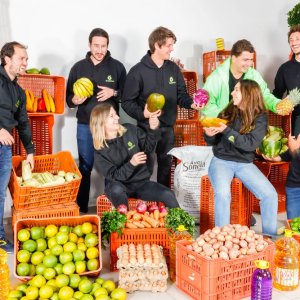Food Waste: Not Just an Ecological Issue

STORY INLINE POST
You’ve heard the numbers over and over: “20 million tons of food go to waste every year in Mexico;” “More than a third of all the food produced ends up in the trash;” “If food waste were a country, it would be the third-biggest in the world from a CO2 emissions standpoint.” Hardly more to add here: If food waste is something you’re remotely concerned about, you know it’s an ecological catastrophe that needs addressing.
The social dimension of the problem is less discussed though, although arguably not less critical. While more than 23 percent of the Mexican population lives in hunger (CONEVAL, 2022), perfectly edible food keeps being routinely thrown away on a daily basis in quantities that typically surpass the minimum necessary to feed them — and this observation scales to the rest of the world. Food waste has been qualified in the past as the “world’s dumbest problem,” and this is no surprise: it seems like a “simple” food redistribution problem that must have workable solutions, doesn’t it?
So, what are the blockers? One would argue there are three major ones: economics, logistics, and perception. Let’s break it down, starting with the latter.
The perception issue comes from both sides of the consumption equation: some vendors might worry about damaging their reputation or even exposing themselves to legal risks for distributing their excess food to low-resource populations. Meanwhile, some consumers might distrust the quality or edibility of those products. This comes down to education on the subject. A few examples:
- excess food is not trash: it’s generally the result of overproduction or unrealistic quality/beauty standards, and ends with relatively high-quality, fresh products going in the bin
- distributing unsold food to the hungry is not — should not — be detrimental to a business’ reputation: it shows empathy, awareness and care
- legal risk is a non-issue: empirical evidence does not point to any brand being sued for donating excess food to the poor. Yet, some, however, choose to destroy their unsold merchandise, worried about legal exposure.
Education is a major challenge when it comes to food waste, since the lack of it can invalidate efforts to convince corporations or institutions to take actions, or the general population to push for it.
Economics: For most food-insecure people, food is simply too expensive to satisfy hunger 100 percent of the time. Significantly cutting prices on food, especially on necessary goods, could then be a way to partially solve the problem. Easier said than done, until we remember that wasted food does not currently generate any revenues and can, hence, be distributed for a (much) lower price with mostly economic upsides. So how about lowering prices on products that don’t comply with unreasonable beauty standards, so they can be consumed instead of thrown away? How about cutting prices on over-produced items, so supply gets matched with a newly generated demand? How about donating food when possible, so the bottom of the pyramid can eat, too? Food banks, as well as a number of food tech companies are currently hard at work making this happen.
Logistics: In many cases, physical access to food can be the challenge to satisfying hunger. Seventy-six percent of the poor in Mexico live in rural areas, where food options are limited. In urban areas, the most affordable options can be a long trip away or, in the most extreme economic situations, almost nonexistent within a reasonable radius. Resolving this issue would then involve one of two things: ideally, bring more affordable options closer to those who need them, or — less sustainable — build the infrastructure enabling those to get to further away options in a reasonable time. Food banks expanding their networks, some logistics/infrastructure projects and companies working on cutting prices of food are all part of the solution.
Cheaf, a startup for food waste management in Mexico, is trying to impact all three of the above blockers. A marketplace for excess food at the distribution level, its mission is to “put an end to food waste by making excess food the cheapest option to eat, everywhere, for everyone.” By selling those products for a third of their original price, it tackles the issue of economic access to food, especially when getting to large distribution centers (e.g. supermarkets), where a significant price cut there can allow low-resource families to have access to very affordable food on a daily basis. By distributing this food directly in the stores that sell them, it creates a dense network of cheap options and can hopefully solve part of the logistics issue at scale by making previously unaffordable nearby options suddenly affordable. By encouraging its vendors to donate part of the earnings they make through Cheaf to food banks, it closes the loop on both issues: addressing the bottom of the pyramid and allowing populations not immediately near a Cheaf option to possibly benefit from it anyway. And by educating its followers on social media, opening the debate in the media sphere, and approaching institutions and corporations directly, Cheaf takes part in growing the level of education around food waste in Mexico, hoping to make it part of public awareness.
No doubt, food waste is a threat to the environment and the mere impact it has on global warming should make us all want to take immediate action. This is not all though: the world is producing more food than is necessary for everyone to eat; however, food insecurity exists and is rampant.
More than just the “world’s dumbest problem,” food waste has the potential to be among the highest-impact problems to solve, and we should try.
























